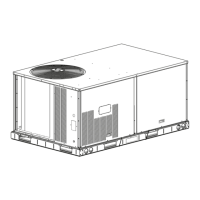21
Fig. 31 — Defrost Control Board Location — 50GCQ*04-06 Electro-Mechanical Units
Reversing Valve Control
The DFB has 2 outputs for unit reversing valve control. Operation
of the reversing valves is based on internal logic; this application
does not use an “O” or “B” signal to determine reversing valve po-
sition. Reversing valves are energized during the cooling stages
and the defrost cycle and de-energized during heating cycles.
Once energized at the start of a cooling stage, the reversing valve
will remain energized until the next heating cycle demand is re-
ceived. Once de-energized at the start of a Heating cycle, the re-
versing valves will remain de-energized until the next cooling
stage is initiated.
Compressor Control
The DFB receives inputs indicating Stage 1 Cooling, Stage 2
Cooling and Stage 1 Heating from the space thermostat or unit
control system (SystemVu
™
controller or RTU Open controller); it
generates commands to start compressors with or without revers-
ing valve operation to produce Stage 1 Cooling (one compressor
runs), Stage 2 Cooling (both compressors run) or Stage 1 Heating
(both compressors run).
Auxiliary (Electric) Heat Control
The 50GCQ unit can be equipped with one or 2 auxiliary electric
heaters, to provide a second stage of heating. The DFB will ener-
gize this Heating System for a Stage 2 Heating Command (heaters
operate concurrently with compressor(s) in the Stage 1 Heating
cycle), for an Emergency Heating sequence (compressors are off
and only the electric heaters are energized) and also during the De-
frost cycle (to eliminate a “cold blow” condition in the space).
Table 7 — 50GCQ Defrost Board I/O and Jumper Configurations
a,b
POINT NAME TYPE OF I/O CONNECTION PIN NUMBER UNIT CONNECTION NOTE
INPUTS
G Fan DI, 24 vac P2-3 CTB-G
Y1 Cool 1 DI, 24 vac P2-5 CTB-Y1
Y2 Cool 2 DI, 24 vac P2-4 CTB-Y2
W1 Heat 1 DI, 24 vac P2-7 CTB-W1
W2 Heat 2 DI, 24 vac P2-6 CTB-W2
R Power 24 vac P3-1 CONTL BRD-8
C Common 24 vac P3-2 CONTL BRD-4
DFT 1 DI, 24 vac DFT-1 to DFT-1 —
DFT 2 DI, 24 vac DFT-2 to DFT-2 —
OUTPUTS
IFO Fan On DO, 24 vac P3-9 REHEAT/HP-2
OF OD Fan On DO, 24 vac OF OFR
RVS1 DO, 24 vac P3-7 to P3-5 — Energize in COOL
RVS2 DO, 24 vac P3-6 to P3-4 — Energize in COOL
COMP 1 DO, 24 vac P3-10 FPT1-REHEAT/HP-6
COMP 2 DO, 24 vac P3-8 FPT2-REHEAT/HP-8
HEAT 2 DO, 24 vac E-HEAT TB4-1
COM 24 vac P3-3 TB4-3
CONFIGURATION
Select Jumper 24 vac P1-1 —
SPEED-UP CONFIGURATION
Speed-Up Jumper —JMP17—
Speed-Up Jumper —JMP18—
a. Jumper for 1-3 seconds: Factory Test — The defrost interval timing is reduced by a factor of 0.1 seconds/minute based on the positions of DIP switches SW1 and SW2
(i.e., 90 minutes will be reduced to 9 seconds).
b. Jumper for 5-20 seconds: Forced Defrost — Defrost runs for 30 seconds if DFT2 is open.

